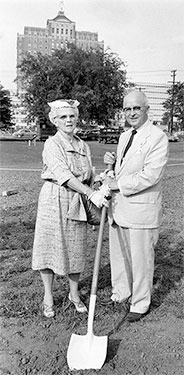 Margaret Cameron and Frank SpainSpain Rehabilitation Center marks its 50th anniversary in the same way as its dedication — with a scientific program that demonstrates its commitment to providing the finest care supported by research and teaching.
Margaret Cameron and Frank SpainSpain Rehabilitation Center marks its 50th anniversary in the same way as its dedication — with a scientific program that demonstrates its commitment to providing the finest care supported by research and teaching.
Fifty years ago, on April 26, 1964, a formal dedication ceremony marked the opening of the Spain Rehabilitation Center, a new facility for inpatient physical therapy on UAB’s Medical Center campus. A day earlier, pioneers in the field of rehabilitation, including Mary Elizabeth Kolb, president of the American Physical Therapy Association, and A. B. C. Knudson, M.D., director of physical medicine and rehabilitation service for the Veterans Administration, gathered for a scientific program. Howard A. Rusk, M.D., considered the “father of comprehensive rehabilitation medicine,” also spoke at the dedication.
History repeats itself April 25 when a scientific symposium on traumatic brain injury gathers leading rehabilitation professionals to discuss evaluation and rehabilitation, psychosocial deficits, novel treatment strategies for TBI and more on the eve of its anniversary.
“Spain Rehab Center has been a source of hope and support for thousands of individuals over the years,” said Amie McLain, M.D., chair of the Department of Physical Medicine and Rehabilitation. “We stress a rigorous, evidence-based and patient-centered rehabilitative experience that includes family participation as vital to recovery.”
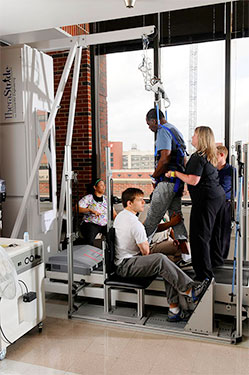 Equipment used today for patients.In the beginning
Equipment used today for patients.In the beginning
That legacy began when local philanthropist Margaret Cameron Spain, an advocate for disabled children and adults, heard a renowned specialist insist that Alabama would only make strides in rehabilitation when a diagnostic, evaluation, treatment and teaching facility was created that was connected with Birmingham’s School of Medicine. She became convinced of that truth, and along with her husband Frank, approached UAB's Joseph Volker in 1959 about supporting construction of a teaching medical rehabilitation facility. Ground was broken in 1962.
The initial 63,000-square-foot, three-story facility — made possible in part by a $500,000 gift from Frank E. and Margaret Cameron Spain and funding from the Foundation for Hearing and Speech — opened with 58 inpatient beds.
A School of Physical Therapy was created and the first students were admitted in fall 1964. Specialized training for nurses in the rehabilitation hospital was expanded to include nurses across all hospital services, and nursing students and rehabilitation rotations were added to nursing student curriculum.
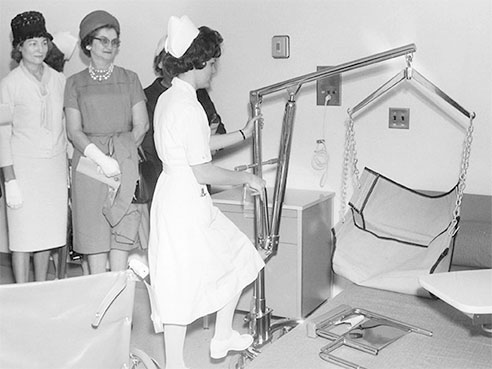 Equipment available for patients in 1964.Within the year, interdisciplinary research expanded to include rheumatology, stroke, mental retardation and more. In 1966 Spain Rehabilitation Center was designated Medical Rehabilitation Research and Training Center No. 19 by the U.S. Department of Health Education and Welfare, and was able to gather continuing support for broad-based education and training programs.
Equipment available for patients in 1964.Within the year, interdisciplinary research expanded to include rheumatology, stroke, mental retardation and more. In 1966 Spain Rehabilitation Center was designated Medical Rehabilitation Research and Training Center No. 19 by the U.S. Department of Health Education and Welfare, and was able to gather continuing support for broad-based education and training programs.
In its first four years, more than 1,600 inpatient admissions and 12,000 outpatient visits were recorded, and two floors and 20 inpatient beds were added in 1969.
Future of rehabilitation medicine
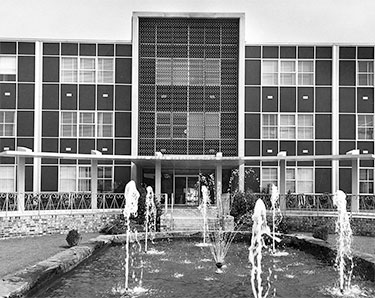 Spain Rehab 1964Today, with all-private rooms, SRC is a 49-bed rehabilitation hospital featuring advanced care for adolescent and adult patients recovering from a variety of health problems.
Spain Rehab 1964Today, with all-private rooms, SRC is a 49-bed rehabilitation hospital featuring advanced care for adolescent and adult patients recovering from a variety of health problems.
In the years since its founding, Spain Rehab has become an integral part of the UAB Health System and the headquarters of the Department of Physical Medicine and Rehabilitation. The Spinal Cord Injury Model System of Care has had continuous funding since 1972, the National SCI Statistical Center since 1985 and the Traumatic Brain Injury Model System of Care since 1998.
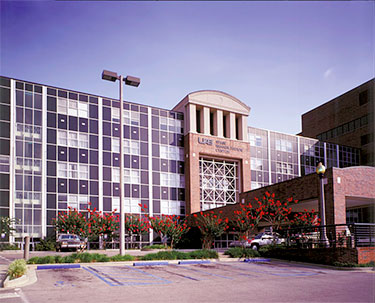 Spain Rehab 2014A residency program began in 1988 with five residents and grew to its current level of 12 resident slots in 2005. A 1991 building expansion allowed the outpatient clinic to grow from two to 12 rooms and added more space for therapy, research and offices.
Spain Rehab 2014A residency program began in 1988 with five residents and grew to its current level of 12 resident slots in 2005. A 1991 building expansion allowed the outpatient clinic to grow from two to 12 rooms and added more space for therapy, research and offices.
The Samuel Stover, M.D., Assistive Technology Laboratory was established in 2008 with major funding from the Christopher and Dana Reeve Foundation. The lab helps SCI patients use computer-based equipment to help them deal with disabilities. In 2010, SRC developed its first neuroregenerative science research program.
Black-and-white images courtesy of UAB Archives
